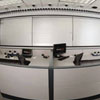
Certify VMS Software
- By Ralph C. Jensen
- Jul 01, 2012
No one likes taking tests, or the testing
process, until now. Arecont Vision set
up its own MegaLab several years ago
to ensure the integration of its own
suite of cameras with industry-leading
NVRs and video management system software solutions.
It is a testing process that makes the best even better
by lining up to become part of Arecont Vision’s
technology partner program. The idea is the brainchild
of Jason Schimpf, Arecont Vision’s director
of partner relationships, and resides in
the company’s Glendale, Calif., offices. The
MegaLab is meant to test integration and
load performance with the assistance of a
quality assurance engineer. Those involved
in the testing also work hand-in-hand with
company development engineers.
“The MegaLab is the perfect tool to assist
our efforts in expanding the integration
of Arecont Vision megapixel cameras, while
companies can test their compatibility with
complementary state-of-the-art technologies,”
Schimpf said. “What we’ve done is created a
test ground in a comfortable setting for software
workers. They can visit our facility and test their products
for themselves.
“There is nothing like getting a hands-on experience during
the testing phase. The more testing we complete in our Mega-
Lab ensures a better integration of our megapixel cameras with
our partners.”
The MegaLab provides a level of integration that partners
are able to quantify using their own open-architecture platforms
with Arecont Vision cameras in a completely agnostic
environment. The concept is to determine the integration of
a camera and which camera features—e.g., quality, saturation
and brightness—are controlled by the VMS.
Rob Shaw, president of Video Insight, had high praise for
the lab because it allows his staff of engineers to load test a
bank of cameras with their video management system. He was
equally impressed with the way his VMS worked so smoothly
with the Arecont Vision panoramic camera.
“There are a number of schools that we have worked with
that have that panoramic camera,” said Shaw, who was awarded
the Arecont Vision VMS of the year in the education vertical.
“Using the lab allows us to test without having to be in the
actual customer environment, and it allows us not to have to
put up hundreds of cameras to test the software.”
Staged in the back offices at Arecont Vision headquarters,the MegaLab would be easy to miss
without a guided tour. The thing that
stands out is the straight line of cameras
at ceiling height constantly monitoring
two giant, high-definition screens.
The cameras watch in full color as the
partners begin their testing. Testing
began in 2010, and testers are frequent
visitors to the lab facilities.
A Milestone Solutions engineer who
worked with the certification said that
the MegaLab is “definitely impressive.
It is nice to have access to all of the
cameras there so we can test capabilities
across the board.”
In fact, Arecont Vision has set up a
program through which remote testing
can take place. In the past two years,
more manufacturers have used the remote
option rather than physically
spending a couple days in the Glendale
offices to test their own products. An
average certification generally lasts one
day, but it’s not unusual for a software
developer to spend up to three days
performing product testing.
“This MegaLab certification provides
a double-check for Milestone to
verify the integration is solid between
our software and their hardware,” said
Martin Friis-Mikkelsen, head of strategic
alliances at Milestone Systems. “We
have the ability to test our integration
on a large volume of Arecont Vision
cameras at once.”
Because the testing facilities are agnostic
and programs do not favor one
manufacturer over another, there is no
finger pointing when it comes to finding
and fixing a problem. In fact, Schimpf
said that when a problem is found, everyone
involved in the test focuses on
the fix rather than “who did it.”
The Milestone device driver developers—
who program the integration
between XProtect VMS and alliance
partners’ hardware devices—do their
own final stability testing of new camera
models running with a mix of different
camera brands. The MegaLab
allows partners such as Milestone to
also check performance with several
megapixel cameras at once. It means a
lot to Milestone engineers, who test certain
configurations and system loads,
but also for the development team in
the Copenhagen headquarters working
with new releases.
“The certification will carry extra
weight for system installers and end users
alike, helping the channel to more
confidently sell and implement our
joint solutions,” Friis-Mikkelsen said.
“We work closely with our partners,
collaborating for the benefit of customers
and the industry as a whole towards
mutual success for all involved.”
The MegaLab has a quad core
server with hot-swappable hard drives
connected to more than 100 cameras,
all of which are a brand off of the
Arecont Vision shelves.
The MegaLab has a dedicated gigabit
network and a server rack with
KVM to secure the partner’s appliance
equipment. In addition to a dual quad
core server option, it also has a quad
core client PC with dual 24-inch display
in the clean work environment.
Three certification tests are offered
for camera integration, feature integration
and load testing.
And, soon, the MegaLab will begin
to offer testing outside of the video management
system realm, administering
testing for optics, housings and wireless
solutions.
This article originally appeared in the Security Products Magazine - July 2012 issue of Security Today.